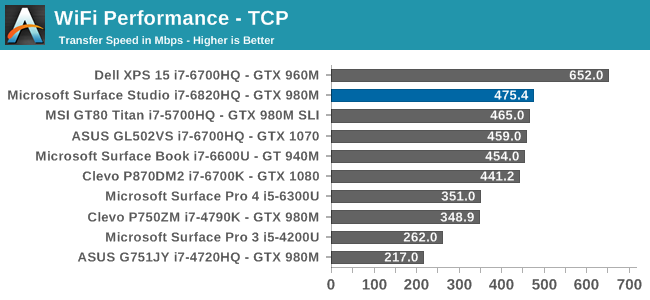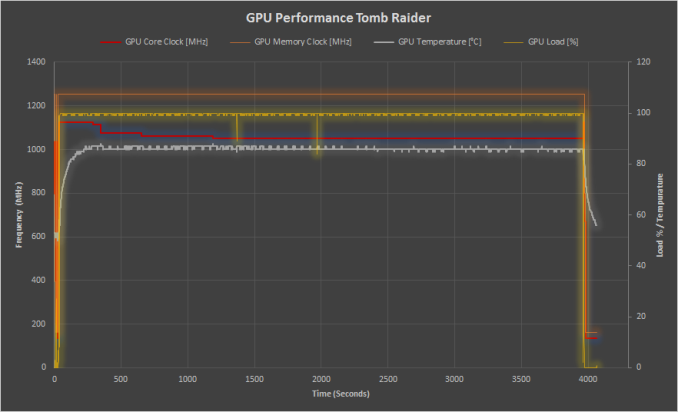The Microsoft Surface Studio Review
by Brett Howse on January 20, 2017 8:00 AM EST- Posted in
- Desktop
- Microsoft
- Surface
- Surface Studio
Wireless
Microsoft has stuck with it’s tried and tested Marvell AVASTAR 802.11ac wireless adapter for the Surface Studio, and they’ve been using this NIC for quite a while on the Surface devices, so this isn’t a surprise. Over the years, the experience with the Marvell adapter has not been the best, although recent driver updates have both improved performance, and made the adapter less prone to not finding networks to connect to.

How times have changed. The Surface Pro 4 in the above graph has the same network adapter, but you can see how far Marvell has come with the drivers. It has been solid so far in regards to connections as well, and hopefully that doesn't change. The Surface Book, with the same adapter, sometimes needs to be restarted to fix the networking even to this day.
The Surface Studio also has the Intel I219-LM Gigabit Ethernet adapter, for those that prefer a wired network connection. It does provide a better experience if you do have a cable handy, since even the best 3x3 802.11ac cards can’t really compete with Gigabit wired.
Audio
When it comes to audio, Microsoft had to put some extra work into the Surface Studio to ensure that the audio experience wasn’t impacted by too severely by moving the display. A lot more engineering went into this than you would expect, and the Surface Studio features a total of seven speakers. Apparently the Surface team decided to go big, or go home, so they fit four speakers into a downward firing grille at the bottom of the display, plus there are two additional speakers in the base. The final speaker is a subwoofer to help out on the low frequencies.
 Four of the Studio speakers are on the bottom edge of the display, and another two plus a sub are in the base
Four of the Studio speakers are on the bottom edge of the display, and another two plus a sub are in the base
The sound quality of the Surface Studio is far better than you would expect for a small, tightly packed device like it is, and having the speakers in multiple locations helps out when the display gets moved into the drafting mode, since the ones on the base can now chip in to make up for the speakers on the display no longer as optimally oriented.
The system gets quite loud, and I measured a maximum of 88 dB(A) when playing music, and the sound was not distorted even at maximum volume. The subwoofer definitely helps out too, with decent frequency response even on the low end of the scale. It’s not a home theater in a box by any means, but it would likely be enough for many people.
Thermals, and Noise
Packing a PC into a space the size of the base of a Surface Studio, especially with a GTX 980M inside, is quite a challenge, but ensuring that the system does not overheat, even under load, is often too much for small devices like this. There are two fans inside the Surface Studio, and they vent out a row of slots in the black plastic underneath the computer.
When discussing the cooling with the Surface team, they were very proud of the work they had done there, especially the amount of heat dissipated per dB of noise. In order to test the thermal capabilities of the Surface Studio, the Tomb Raider benchmark was run continuously at 1920x1080 Ultra settings, which loads the GPU up to 100%.
The cooling system is very good in the Surface Studio, despite the significant heat generated by the GTX 980M. The system was able to run for five minutes at maximum boost clock of 1126 MHz before the GPU hit the thermal limit of 87°C, at which point it reduced its frequency to 1050 MHz over time, and stayed right there for the rest of the test. Perhaps the most impressive bit is that even with the GPU at 100% load, the sound pressure level with a meter over the keyboard, was just 46 dB(A), and the sound frequency is low enough that it isn’t bothersome. Microsoft did their homework on the cooling system, and the Surface Studio is solid under load.
Where it is let down though is at idle. Despite being very quiet under load, at idle, the system still produces 37.5 dB(A), and the fans constantly run. The CPU and GPU idle around 39°C, which is very reasonable, but the sound is always there. It’s not loud, but it’s always there. For me, desktop systems should be almost silent under light workloads, but that’s not the case on the Studio, which is disappointing.
The other issue on the noise side, at least on this review unit, is that there is a small amount of coil whine when the system has the display off, but it’s not yet sleeping. Most likely, this is the power supply, which is also built into the base of the Studio, coping with the reduced power demand since it isn’t driving the display backlight anymore. Once it goes to sleep, it’s not an issue, but the system does wake up periodically to update email, and the like, so even if it is sitting there asleep on the desk, occasionally the coil whine will come back, and the fans kick in.











197 Comments
View All Comments
fanofanand - Monday, January 23, 2017 - link
My company employs over 260,000 people, and we just got WIN7 last year. We still have some users on XP. So "it takes a couple years for the enterprise world to catch up" is exactly right. Don't underestimate the need for compatibility with legacy applications in older, larger companies. Besides that, it isn't exactly a small undertaking to swap out the OS (or PCs for that matter) when you are literally dealing with hundreds of thousands of users. The enterprise world is VERY slow to adapt outside of Silicon Valley (or the tech sector in general).BrokenCrayons - Friday, January 20, 2017 - link
The Surface Book's biggest problem is its awful hinge design that doesn't let you fully close the system like pretty much every other clamshell design ever. It leaves that awkward gap to keep the screen from making contact with the keyboard that Microsoft couldn't figure out how to recess deep enough to keep it off the screen were they to give it a more effective hinge. I can't imagine anyone would examine the thing and be impressed by those painfully obvious oversights.Friendly0Fire - Friday, January 20, 2017 - link
Funny, the hinge is actually one of the things I like most about the SB. It means the keyboard isn't recessed and I don't have key markings on my screen every time I open it.It's not because it's different that it's bad, you know?
BrokenCrayons - Friday, January 20, 2017 - link
Key blemishes on a screen are as much of an indication of poor design as the shortcut Microsoft took with the Surface Book's hinge. Either way, you're the victim of thoughtless engineering. Though the biggest problem with the Surface Book hinge isn't really the fact that it underscores the error with keyboard placement, but that it robs the entire system of structural strength when closed. Instead of the whole system accepting pressure and distributing it across the entire chassis, one half or another will be forced to endure those forces alone.There's nothing wrong with finding the appearance appealing. It's simply that in either an attempt to create a visual difference or as compensation for poorly thought out system design, Microsoft selected the hinge to the detriment of its customers. It's not a big deal, really. The Surface Book is an inexpensive little system so there's not much lost if one is damaged. It just seems like thoughtlessness on the part of the company demonstrated in a very visual manner for sketchy justification.
Devo2007 - Friday, January 20, 2017 - link
Surface Book inexpensive? Oh, to have disposable income like that to consider a $2000 laptop inexpensive enough to consider it "not much lost if damaged."BrokenCrayons - Friday, January 20, 2017 - link
Money really isn't the point anyway. No matter what the cost relative to income, people reasonably expect their computers to be designed well and to function without a great deal of trouble. I don't think the Surface series in general has been able to live up to the reputation Microsoft is attempting to give it through its marketing. The SB in particular just doesn't translate well from marketing material to functionality due in part to a variety of problems associated with the hinge (and a few other software/hardware glitches). They have earned a reputation as quirky and unreliable which doesn't help Microsoft land sales.fanofanand - Monday, January 23, 2017 - link
Come back down to earth Mr Crayons, the SB is NOT an inexpensive product. I agree with the rest of your post but you are showing your elitism with a statement like that.BrokenCrayons - Monday, January 23, 2017 - link
I'm sorry! I was really trying to focus on the design and not so much the cost.Manch - Sunday, January 22, 2017 - link
That hinge can handle a lot of stress. Its been proven that durability is not an issue. The purpose of the hinge design was to counter the screen/tablet weight for proper balance when in laptop mode. So what is it exactly that's so poor in its design?BrokenCrayons - Monday, January 23, 2017 - link
You'll see it a couple posts up from the one you replied to.